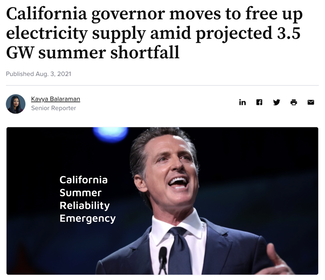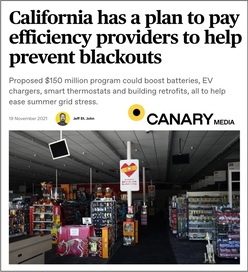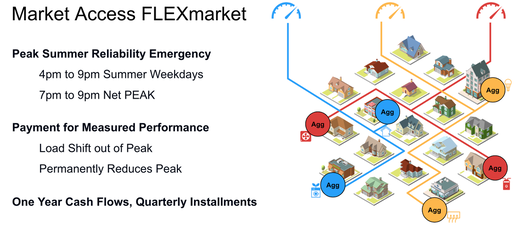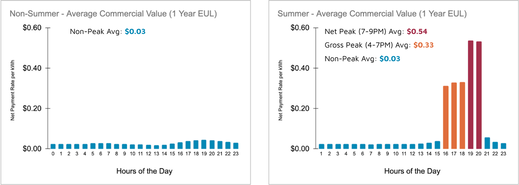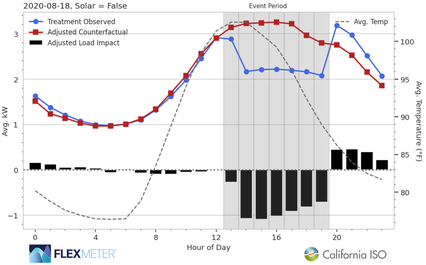|
In his Sonoma County TEDx talk Recurve CEO Matt Golden explains how the FLEXmarket Virtual Power Plant approach encourages market innovation, supports local jobs, helps customers reduce energy costs, supports decarbonization goals and helps mitigate the looming grid crisis, while improving building comfort, air quality, and resiliency.
Virtual Power Plants based on behind the meter distributed energy resources are increasingly essential to enable a stable and decarbonized grid. |
|
California Market Access
|
In response to California's 2022 forecasted 4.4 GW electric capacity shortfall and Governor Gavin Newsom’s Emergency Proclamation, the California Public Utilities Commission (CPUC) has passed a decision (latest version here) creating a new Market Access program to deliver peak or net peak demand savings to improve summer grid reliability.
The Market Access Program is based on MCE and Recurve’s FLEXmarket and opens the opportunity for any load serving entity to stand up a similar VPP market in their service territory. Recurve’s Demand FLEXmarket model is standing ready to address peak challenges and accelerate the implementation of energy efficiency and demand response as a demand-side resource. |
|
"After two summers in a row of grid emergencies, California utilities and regulators are searching for all kinds of ways to prevent the risk of blackouts in summers to come. The latest idea? Cut the complexity from the utility programs that pay such companies for reducing energy use when the grid is under the most stress.
The proposal is to let those companies experiment with business models that could offer residential and commercial customers energy-efficiency retrofits and upgraded appliances and equipment, or outfit them with batteries and electric vehicle chargers that can store and shift energy use. Then measure the hour-by-hour results and pay the companies every month for their demonstrated contributions to stabilizing the state’s grid." |
Long-Term, Dispatchable Load Shaping
|
The Recurve Platform tracks the savings of every project monthly at a site-level, then for payment at the portfolio-level. Aggregators can track their projects savings in their instance of the Recurve Fleet Manager and value via Flex Ledger. All Calculations are open-source with market rules guided by the CPUC Normalized Metered Energy Consumption CPUC rulebook.
You can explore the CPUC's Avoided Costs values with Value Explorer, built on the open source FLEXvalue engine. Aggregators are paid quarterly based on the first year's impact for measured grid value at the meter.
|
FLEXmarket Combines EE & DR Under the Population NMEC Regulatory Framework
All FLEXmarkets are structured to classify as 'Population NMEC programs' and do not have fixed measures or incentives. The program-specific M&V plan will describe the approach and associated software tools for calculating actual payable savings. Learn more about population NMEC here.
The public, open source CalTRACK 2.0 methods, executed via the Linux Foundation Energy OpenEEmeter for the calculation of baseline models and counterfactuals, GRIDmeter for comparison group sampling and savings adjustment, and FLEXvalue for the calculation of grid value based on the measured hourly savings impact and the CPUC’s avoided cost calculator determine payable savings.
The open-source methods and codebase can collectively be called the FLEXmeter. The FLEXmeter methods and code will be used for quantifying energy efficiency impacts.
The public, open source CalTRACK 2.0 methods, executed via the Linux Foundation Energy OpenEEmeter for the calculation of baseline models and counterfactuals, GRIDmeter for comparison group sampling and savings adjustment, and FLEXvalue for the calculation of grid value based on the measured hourly savings impact and the CPUC’s avoided cost calculator determine payable savings.
The open-source methods and codebase can collectively be called the FLEXmeter. The FLEXmeter methods and code will be used for quantifying energy efficiency impacts.
Open-Source Revenue-Grade Measurement
Our open-source methods and codebase can collectively be called the FLEXmeter. This includes the public, open source CalTRACK 2.0 methods, executed via the OpenEEmeter for the calculation of baseline models and counterfactuals, GRIDmeter for comparison group sampling and savings adjustment, and FLEXvalue for the calculation of grid value based on the measured hourly savings impact.
Transparent
|
Replicable
|
Available
|
Stakeholder
|

